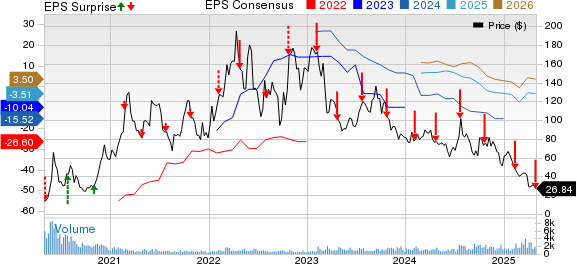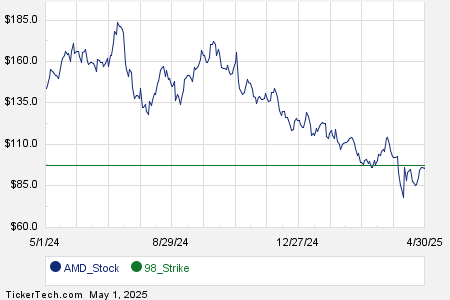Nabors Industries Reports Wider Loss Amid Revenue Challenges in Q1 2025
Nabors Industries Ltd. (NBR) reported a first-quarter 2025 adjusted loss of $7.5 per share, significantly exceeding the Zacks Consensus Estimate of a loss of $2.64. This decline stemmed mainly from reduced adjusted operating income in its U.S. Drilling segment and represents a deterioration from the previous year’s loss of $5.16 per share.
Despite this setback, the oil and gas drilling company’s operating revenues of $736.2 million surpassed the Zacks Consensus Estimate of $718 million. This boost was fueled by stronger performance in the International Drilling segment. However, revenues dropped from $743.9 million reported in the same quarter last year, attributing the decline to weak contributions from both the U.S. Drilling and Drilling Solutions segments.
Moreover, adjusted EBITDA fell to $206.3 million compared to $221 million a year earlier, missing our model estimate of $221.6 million.
Nabors Industries Ltd. Price, Consensus and EPS Surprise

Nabors Industries Ltd. price-consensus-eps-surprise-chart | Nabors Industries Ltd. Quote
In March, Nabors completed the acquisition of Parker Wellbore, enhancing its portfolio with complementary assets. This strategic move adds Quail Tools, the leading tubular rental provider in the U.S., and establishes strong casing running operations in Saudi Arabia and the UAE. The acquisition is projected to positively impact Nabors’ free cash flow in 2025 and improve its leverage profile.
During the first quarter, the SANAD joint venture deployed its 10th new rig. Additionally, the 11th rig commenced operations in April, with a 12th scheduled to begin later in the second quarter. Two additional rigs are expected to come online in the latter half of 2025, which should considerably boost SANAD’s adjusted EBITDA while supporting customer production capacities for natural gas development.
Nabors has expanded its strategic alliance with Corva AI by integrating Corva’s AI-driven analytics into its RigCLOUD platform. This partnership combines Nabors’ edge and cloud computing capabilities with Corva’s advanced analytics, enhancing real-time data processing and operational performance.
In March, Nabors halted operations on three rigs in Russia due to newly expanded sanctions. The likelihood of resuming activity in this market appears low, given the marginal financial performance observed previously.
NBR’s Segmental Performance Overview
U.S. Drilling reported operating revenues of $230.7 million, a 15.2% decrease from $272 million in the same quarter last year. Nonetheless, this figure exceeded our model estimate of $221.6 million. Operating profit was $31.6 million compared to $50.5 million a year earlier, missing our forecast of $45 million.
International Drilling saw revenues rise to $381.7 million from $349.4 million a year ago. This result also surpassed our estimate of $357.1 million. The operating profit grew to $33 million, improving from $22.5 million in the previous year and exceeding our forecast of $26.6 million.
Revenues from the Drilling Solutions segment reached $93.2 million, marking a 23.3% increase from $75.6 million in the prior-year quarter. This exceeded our estimate of $78.7 million, with operating income rising to $32.9 million from $26.9 million a year earlier, beating our prediction of $28 million.
The Rig Technologies segment generated revenues of $44.2 million, down 11.9% from $50.2 million in the prior-year quarter, and missed our estimate of $47.6 million. However, operating profit edged up to $4.3 million compared with $4.2 million last year, surpassing our estimate of $3.5 million.
Nabors Financial Position
Nabors’ total costs and expenses declined to $670.6 million from $736.9 million in the previous year, also below our prediction of $711.4 million.
As of March 31, 2025, Nabors held $404.1 million in cash and short-term investments. The company’s long-term debt stood at approximately $2.7 billion, with a total debt-to-total capital ratio of 80.5%. Capital expenditures during this period totaled $159.2 million.
NBR’s Guidance for Future Performance
U.S. Drilling: For the second quarter of 2025, Nabors anticipates the Lower 48 average rig count will range from 63-64 rigs, with a daily adjusted gross margin of around $14,100. In Alaska and the Gulf of Mexico, adjusted EBITDA is expected to be about $26 million.
International: The company projects an average international rig count of 85-86 rigs for the upcoming quarter, including two rigs from Parker, with a daily adjusted gross margin of approximately $17,700.
Drilling Solutions: Nabors forecasts adjusted EBITDA of roughly $75 million for the second quarter of 2025, factoring in an estimated $43 million contribution from Parker operations.
Rig Technologies: Expected adjusted EBITDA for this segment in Q2 2025 is predicted to align closely with Q1 results.
Capital Expenditures: Anticipated capital expenditures for Q2 2025 are projected between $220 million and $230 million, which includes $35 million for Parker operations and $100 million to $105 million for new builds in Saudi Arabia. For the full year 2025, Nabors expects total capital expenditures around $770-$780 million, with $360 million earmarked for SANAD new builds and $60 million for Parker.
Nabors Projects $80 Million Cash Flow, Highlights Key Joint Ventures
Free Cash Flow Forecast: Nabors Industries anticipates adjusted free cash flow of approximately $80 million for the entire year of 2025, excluding any tariff effects. The SANAD Joint Venture is expected to absorb about $150 million, while other operations, including Parker, are projected to generate around $230 million.
SANAD Joint Venture Outlook: The SANAD Joint Venture is projected to exceed $300 million in EBITDA in 2025, showcasing robust operational performance. The company plans to introduce five newbuilds each year to support ongoing EBITDA growth. Additionally, Nabors’ management has indicated that an IPO for SANAD is a significant strategic option currently being evaluated.
Earnings Snapshot: Key Findings
While previously discussing Nabors’ first-quarter performance, let’s examine three important reports from related companies in this sector.
Liberty Energy, an oil and gas equipment and services provider, recorded first-quarter 2025 adjusted net income of 4 cents per share, slightly surpassing the Zacks Consensus Estimate of 3 cents. This growth reflects enhanced operational efficiencies and improved utilization of frac and wireline fleets. However, the results fell short of the previous year’s 48 cents due to decreased service activity.
As of March 31, Liberty held about $24.1 million in cash and cash equivalents. The company reported a long-term debt of $210 million, yielding a manageable debt-to-capitalization ratio of 9.6%.
Halliburton Company also released its earnings, posting first-quarter 2025 adjusted net income per share of 60 cents. This met the Zacks Consensus Estimate but was lower than the adjusted profit of 76 cents from the prior year. The results indicate softer North American activity, somewhat offset by gains internationally. Halliburton’s revenues totaled $5.4 billion, a decrease of 6.7% year over year, yet exceeded the Zacks Consensus Estimate of $5.3 billion.
As of March 31, 2025, Halliburton reported approximately $1.8 billion in cash and cash equivalents against $7.2 billion in long-term debt, resulting in a debt-to-capitalization ratio of 40.8%.
Finally, Baker Hughes reported first-quarter 2025 adjusted earnings of 51 cents per share, surpassing the Zacks Consensus Estimate of 47 cents. This figure marked an improvement from the previous year’s earnings of 43 cents.
As of March 31, 2025, Baker Hughes held cash and cash equivalents of $3.3 billion and reported long-term debt of $6 billion, leading to a debt-to-capitalization of 25.9%.
Conclusion
The financial results of Nabors and its peers provide insight into the oil and gas equipment sector’s stability and operational performance. Monitoring these developments will be crucial for investors and stakeholders moving forward.
The views and opinions expressed herein are those of the author and do not necessarily reflect those of Nasdaq, Inc.


